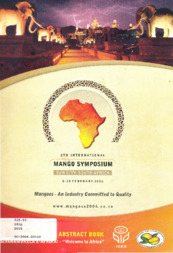Effects of postharvest handling on lenticel spotting of 'Tommy Atkins' mangoes from Northeast Brazil.
Effects of postharvest handling on lenticel spotting of 'Tommy Atkins' mangoes from Northeast Brazil.
Author(s): ASSIS, J. S. de; SELF, G.; CARON, V. C.
Summary: Both red and black lenticel spotting reduce the value of Tommy Atkins mangoes exported from northeast Brazil to North America and Europe. By applying none, some ar ali postharvest operations to early and mid-season fruit, it was shown that postharvest handling increases lenticel spotting in a cumulative way. Both types of lenticel spotting were caused principally by washing fruit in a calcium hydroxide solution to prevent sap burn. Following this, the USDA phytosanitary hot water treatment reduced the potential for subsequent red lenticel spotting during cold storage, but increased black lenticel spotting. The result of these reciproca I effects is that fruit for the EU market, which does not receive the hot water treatment, is affected principally by red spotting, and fruit for the US market by black spotting. It is suggested that black lenticel spotting occurs principally through physical processes involving the entry of water into the lenticels and the subsequent collapse and discolouration of sub-Ienticellular cells. In contrast, red lenticel spotting is a physiological process involving anthocyanin production in response to low temperature in which water entry to the lenticels plays a role. The observation that lenticel spotting decreases during the season is consistent with the work of Joyce et aI. (2001), and suggests that fruit become more physiologically resistant and that the properties of the lenticels change making them more resistant to water entry and damage as the season progresses. The nature of these changes remains to be determined.
Publication year: 2006
Types of publication: Abstract in annals or event proceedings
Unit: Embrapa Semi-arid Region
Observation
Some of Embrapa's publications are published as ePub files. To read them, use or download one of the following free software options to your computer or mobile device. Android: Google Play Books; IOS: iBooks; Windows and Linux: Calibre.
Access other publications
Access the Agricultural Research Database (BDPA) to consult Embrapa's full library collection and records.
Visit Embrapa Bookstore to purchase books and other publications sold by Embrapa.

